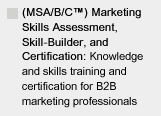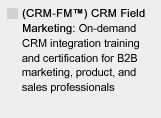MAKE SURE YOU CONTINUE TO RECEIVE EACH ISSUE OF TUESDAY MARKETING NOTES—CLICK HERE TO RENEW YOUR FREE SUBSCRIPTION (IF YOU'VE ALREADY SUBSCRIBED, NO NEED TO RE-SUBSCRIBE)
Google Keyword Power: Developing and Discovering Keywords for Effective B2B Lead Generation Programs
by Eric Gagnon
In previous TMN articles, we've discussed the key role of using content to draw interested potential prospects to your Google AdWords keyword advertising programs, and the importance of developing this content before developing the other elements of your AdWords campaigns.
After you’ve developed this content, in the form of white papers, reports, case studies, etc., and you’ve determined (initially, at least) the products, problems, and applications you believe prospects will be searching to find products like those sold by your company, the next step is to develop the keywords used to drive your AdWords campaign.
Keyword selection is, of course, critical in Google AdWords programs, but even more so for keyword search advertising programs in business-to-business markets. That's because traffic (searches and page views) for most keywords in B2B markets is quite low compared to search volume for keywords of broad interest to consumers, like "travel," "hotels," etc. So, the way to build up search volume in these specialized B2B product categories is to carefully compile as many keywords and keyword phrases to maximize search traffic for your AdWords campaigns.
The process of developing keywords starts with a process of list-making: Begin by making lists of keywords and keyword phrases you believe your potential prospects will use to search for your product on Google. These lists of keywords are sorted into keyword stacks (more on this next week), to further organize keywords by the text ads, information premiums, landing pages, or any other element they are linked to.
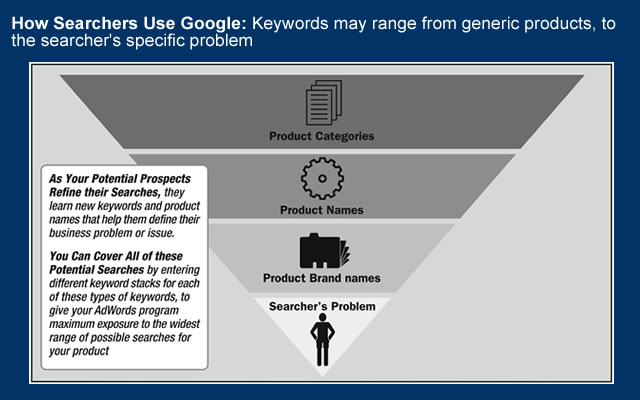
Keywords Describing Your Product
Chances are, many of the people searching for your product will be searching for it by product name or broader product description or type. Product-specific keywords are also most likely to be the keywords generating the highest volume of search traffic on Google. When developing a keyword search marketing program, you’ll be starting out with your initial lists of keywords, and you’ll be adding, deleting, and modifying keywords as you track your program’s impressions, click-throughs, and conversions in response to the keywords you’re using—but the first keyword category to start with are keywords directly related to your product, as shown below:
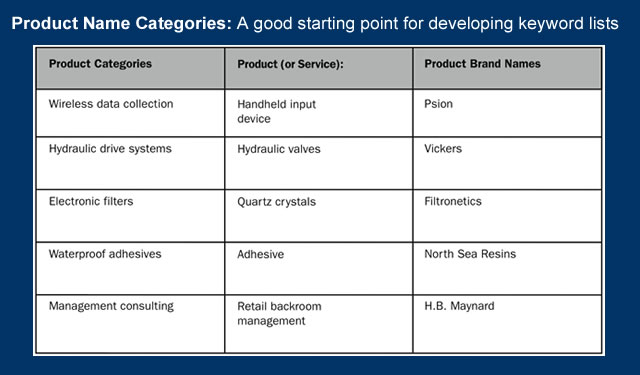
• Product categories: These are broad product categories Web searchers use most often (and often at the beginning of their searches);
• Product names: These are the keywords for specific products or services;
• Product brand names: These are highly-specific product brand names Web
searchers enter as they refine their searches after learning about products
As They Search, Your Prospects Learn More Specific Keywords to Use
When searching for products or services, Web searchers begin by entering keywords for either product names or broader product categories. As they educate themselves to search with more precision, they refine their searches by entering more specific product names, or product brand names, which they learn from their previous searches.
When developing product keyword lists for your product or service, make sure you have covered all of the possible combinations related to your product, its category and any related classifications, and brand names. Once you bring your AdWords program “live” on Google and start generating results, you’ll then see which product keywords generate the highest search traffic; you can then add, remove, or modify these product-related keywords as necessary to improve your click-through rates and reduce your conversion costs.
Keywords Describing the Problem Solved by Your Product
Of course, a keyword searcher may not always have a product in mind when searching Google. Instead, they may have a problem in their business and need a solution to their problem, but they may not even know they need your product, until they discover that a product or service like yours exists, and that it might help them solve their problem. Put yourself in the mind of your potential prospect, and think of the problems or business issues they may be experiencing that drive them to look for products like yours; these are keywords and phrases that your new potential prospects may be entering into Google to find your product.
The table below:
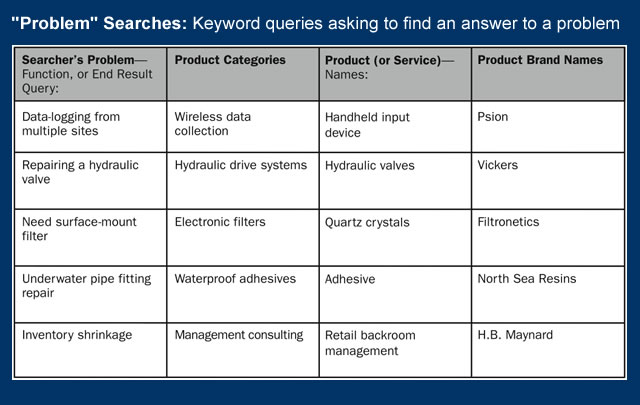
. . . shows examples of problems, expressed as phrases or queries, that searchers might enter on Google to locate possible solutions related to the named products shown.
Keywords describing your product’s functionality and end result: Variations of problem-related searches include queries using keywords that describe the function of a product (i.e., what the searcher wants to do with a product), or the end result they want to achieve using a product such as yours.
By including the keywords, phrases, questions, and queries defining the problems experienced by your potential prospects, and other keywords relating to functionality and end-results, you add an important new dimension to the ways your potential prospects find your company and its products. Also, because many your competitors may overlook these keywords for problem queries, you may sometimes have these keywords all to yourself, which gives you a major competitive advantage when your text ad appears as the first or, better yet, the only ad displayed for these “problem” searches.
Keywords for Market Segments and Specialized Applications
While developing keyword lists, carefully consider the important market segments you want to reach in your AdWords program, and the keyword variations for any other related, specialized applications involving your product. These not only yield additional keywords for your campaign, they may also generate search queries from new or unexpected markets or prospects.
For example, a company selling wireless data collection systems for warehouse and distribution operations can generate additional search queries by adding more search phrases to help it reach into sub-segments of its market:
• refrigeration warehouse IT systems
• food service distribution
• forklift operator terminals
• inventory replenishment systems
You can combine these specialized keywords with more generalized keywords and phrases to target your AdWords program with extreme precision to the prospects who are searching by these highly specialized terms. Internet users who use Google to locate products often use an iterative process, starting with more general search terms, and then using more refined and specific keywords as they learn what to search for, once they gain a better sense of what products are available. With each repetition, they will also search by using new keywords and phrases they gather from Web pages they’ve accessed during their previous searches, and you need to expand your keyword lists to anticipate these actions by your potential prospects. Also, prospects will use different keywords in their searches, depending on how far along they are in their product selection process (we'll discuss this more next week).
When developing a new keyword search program, add as many of these specialized keywords and phrases to your keyword search lists as possible and test them in your AdWords programs. Doing so helps you determine the actual volume of search traffic generated by these keywords. If some of these keywords generate higher impressions than others, they could be worth spinning off into their own, separate AdWords campaigns; this helps you hedge against the risk of limited search traffic that occurs in AdWords programs in B2B markets.
Eric Gagnon (eric@businessmarketinginstitute.com), a director with the Business Marketing Institute, is author of The Marketing Manager’s Handbook and The CRM Field Marketing Handbook.


